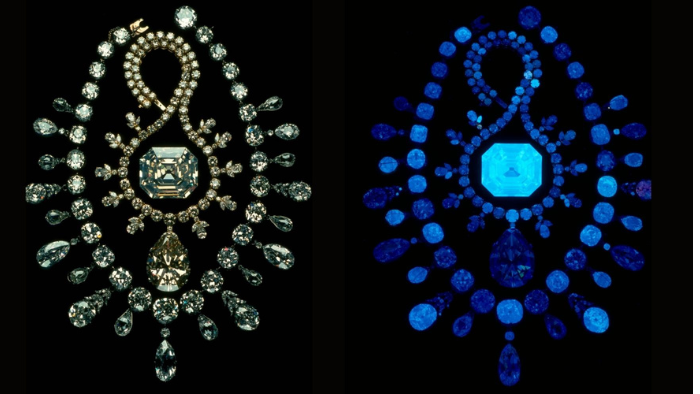Courtesy: Chip Clark, Smithsonian Institution
Diamond fluorescence is a fascinating phenomenon where diamonds glow when exposed to long-wave UV rays. It can sometimes increase or decrease the value of a diamond. It can also affect diamond appearance—or not. How should you take fluorescence into account when choosing the perfect diamond? In this article, we’ll cover:
- What is diamond fluorescence?
- Do all diamonds fluoresce?
- Is there a diamond fluorescence grade?
- Does diamond fluorescence make a yellow diamond look “whiter”?
- Does fluorescence cause haziness in diamonds?
- Can the average person tell the difference between diamonds that do and don’t fluoresce?
- Is diamond fluorescence good or bad?
What is diamond fluorescence?
Fluorescence is the glow you sometimes see when an object emits visible light. Some diamonds fluoresce when they are exposed to long-wave ultraviolet (UV) rays from sources like the sun. This can cause them to emit a bluish light or more rarely, a yellow or orangy light. Once the UV light source is removed, the diamond stops fluorescing.
Do all diamonds fluoresce?
No. Only about 25% to 35% of diamonds exhibit some degree of fluorescence in reaction to long-wave UV light. More than 95% of these diamonds fluoresce blue. A rare few fluoresce other colors such as yellow or green.
Is there a diamond fluorescence grade?
Fluorescence is not a grading factor like the GIA 4Cs (color, clarity, cut, and carat weight), but it is an identifying characteristic. GIA Diamond Grading Reports and Diamond Dossiers describe a diamond’s fluorescence by its intensity under long-wave UV light (None, Faint, Medium, Strong and Very Strong). If the fluorescence is Medium, Strong, or Very Strong, the color of the fluorescence will be noted.
Does diamond fluorescence make a yellow diamond look “whiter”?
Some trade professionals think blue fluorescence enhances a diamond’s appearance, especially in diamonds with I to M color grades. Bluish fluorescence can make a faint yellowish diamond appear more colorless in UV light, which is part of natural daylight. As a result, diamonds with color grades I to N with a very strong to medium bluish fluorescence may have a slightly higher per-carat price than diamonds with similar color grades that do not fluoresce.
The opposite is true for diamonds with higher color grades. In the trade, diamonds in the D to H color range with bluish fluorescence are often considered less desirable than similar grade diamonds without fluorescence, because some people believe that bluish fluorescence may cause diamonds to have a hazy or oily appearance. In a recent study, GIA observed that blue fluorescence has little to no impact on transparency except in extremely rare cases where a diamond (such as the Portuguese diamond) has a light-scattering defect. These defects cause haziness that can sometimes be intensified by strong fluorescence, thus reducing the contrast in the face-up pattern of the diamond. Fluorescence does not cause haziness by itself, however. Also, this “overblue” hazy effect occurs in fewer than 0.2% of the fluorescent diamonds submitted to GIA.
Nonetheless, the association between fluorescence and haziness persists, and diamonds in the D to H range with very strong fluorescence often sell for less than diamonds that do not have fluorescence, even though their color and transparency are most likely unaffected by their fluorescence. These diamonds may prove to be a good deal. If you’re not familiar with the GIA Color Scale, learn more with the GIA Diamond Color Chart.
Does fluorescence cause haziness in diamonds?
No, fluorescence does not cause haziness in diamonds. Fluorescence can increase the pre-existing haziness of a diamond caused by light-scattering defects, thus reducing the contrast in its face-up pattern, but it does not cause haziness in and of itself. As light-scattering defects are incredibly rare, most consumers don’t need to worry about fluorescence impacting a diamond’s appearance in most lighting situations, even if the diamond has Strong to Very Strong fluorescence. But this does mean that consumers should look at a diamond in person. Any haziness intensified by fluorescence, if present, will be noticeable in (for example) daylight-equivalent lighting.

The center diamond is an H color diamond with Strong to Very Strong fluorescence. The two diamonds flanking it on either side are H color diamonds with no fluorescence. There is no visible difference in color or transparency. Courtesy: Jian Xin (Jae) Liao
Can the average person tell the difference between diamonds that do and don’t fluoresce?
In order to study the effect of blue fluorescence on diamond appearance, GIA scientists assembled sets of E, G, I, and K color-grade diamonds. The diamonds in each set were as similar as possible except for the intensity of their blue fluorescence. Diamond graders, trained professionals, and average observers viewed the diamonds in controlled conditions to make a judgment about their appearance. It seems that, for the average observer, meant to represent the jewelry-buying public, no systematic effects of fluorescence were detected. In general, viewers perceived that strongly blue fluorescent diamonds had a better color appearance when viewed table-up. Most observers saw no relationship between fluorescence and transparency.

Seen here are seven diamonds seen under daylight-equivalent illumination versus long-wave UV illumination. Photo: Kevin Schumacher/GIA
Is diamond fluorescence good or bad?
Diamond fluorescence is neither good nor bad. Some people find fluorescent diamonds beautiful and fascinating—others may not. Opinions range across the spectrum.
If you are considering a diamond with bluish fluorescence, look at it under different kinds of lighting, including natural daylight and compare it to other diamonds of the same color grade, and see if you notice any difference. If you do notice a difference, see if you like it!
Now that you know more about diamond fluorescence, read on to learn how light affects a diamond’s appearance.
Custom Field: Array


